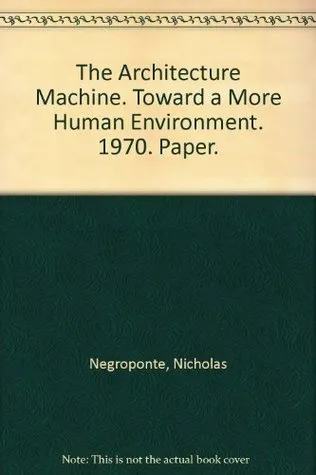The Architecture Machine: Toward a More Human Environment
By (author): "Nicholas Negroponte"
Publish Date:
October 28th 1970
ISBN0262640104
ISBN139780262640107
AsinThe Architecture Machine: Toward a More Human Environment
Original titleThe Architecture Machine
The use of computers to aid the architectural designer and urban planner is already beyond the experimental stage and part of the workaday routine of many professionals. There are, for example, machines that transform two-dimensional drawings into three-dimensional perspective displays and others that check myriad aspects of a design against specifications and tolerance requirements. "The Architecture Machine" looks several machine generations ahead of these to a future in which genuine man-machine dialogue is achieved, when man and machine will act together on something closer to equal terms toward a common goal, each contributing his-its own characteristic faculty.The ideal result would be a final design so seamless and well integrated that it is not possible to tell which partner contributed what, and so creative and innovative, yet contingency-proof, that neither an unaided designer nor the most elaborate computer system could have produced it without the help of the other. Negroponte looks forward to man-machine relationships so personal that each can (politely) interrupt the routine work of the other with a fresh inspiration or a nudging reminder of higher priorities; so personal indeed that the response pattern of a machine to one designer would be significantly different from its dealings with a designer of another temperament or of another culture.Some of the proposals put forth here have already been realized in a system called URBAN5, developed at M.I.T. and IBM by the author and his colleagues. A full account of this system is given. Beyond this, the more radical and adventuresome of the man-machine interactive attributes envisioned by Negroponte are now being created with the coming of more designers (men) trained in the newer technologies and more sophisticated configurations (machines)--and the exploratory interaction of the two.The author has consulted the full literature on systems theory philosophy and has probed deeply into the underlying issues of man-machine relationships and artificial intelligence. It is perhaps not so surprising that an architect rather than a computationist should have provided us with one of the most provocative proposals for humanizing this relationship--architects have always been charged with infusing cold and neutral material with true human dimension and meaning. And although the author's illustrative examples are taken from architecture and planning, the book is equally pertinent to those in other areas in which computer-aided design processes are being pressed into active service. The fact that no specialized knowledge of computers is required will also facilitate the spread of the book's message: "The concern is to avoid dehumanizing a process whose aim is definitely humanization."The text is augmented with over 200 illustrations. The pictures are independent of the text, and the reader should be able to grasp much of the meaning from the pictures and captions alone.
